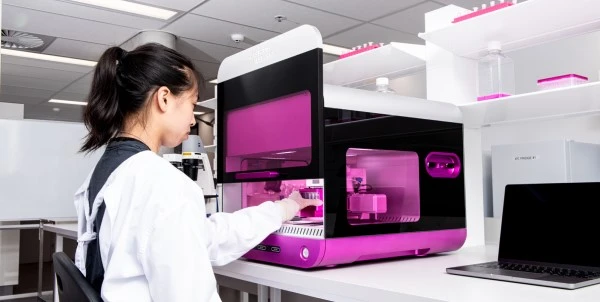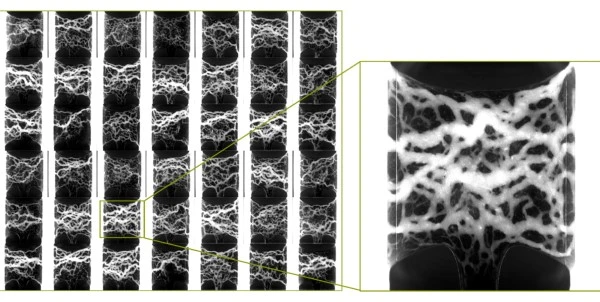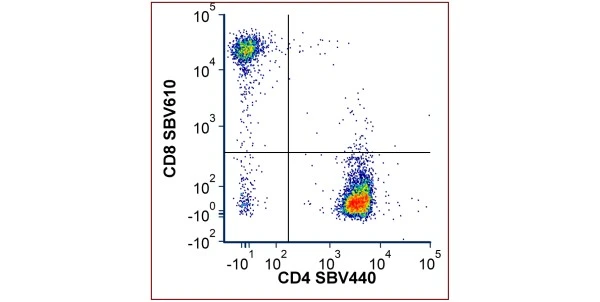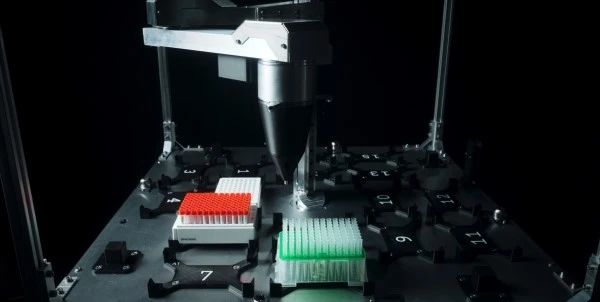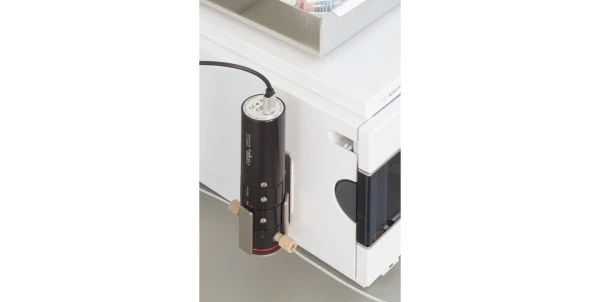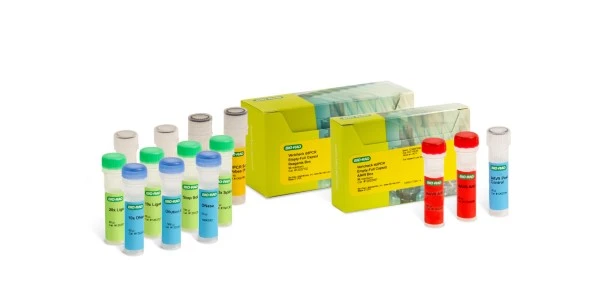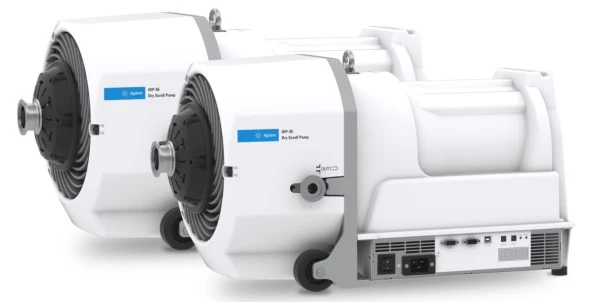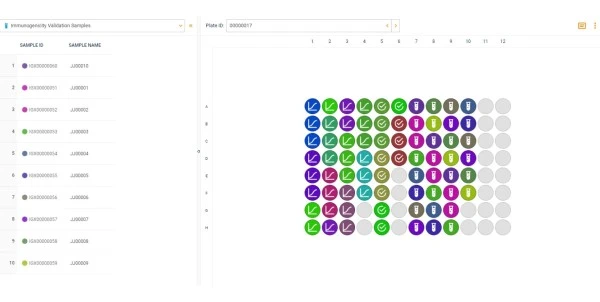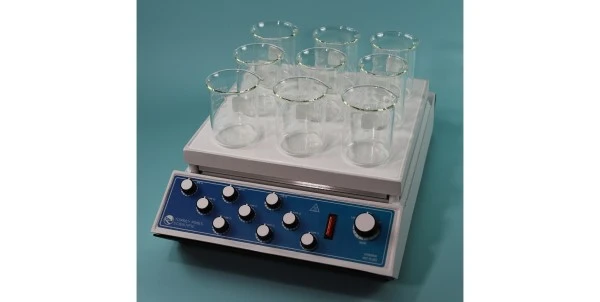
Capillary Electrophoresis: Instrument Price and Cost Considerations
A Guide to Capillary Electrophoresis Systems, Prices, and Cost Considerations
The price of Capillary Electrophoresis instruments varies according to the type, scale, and functionality, among other factors. Capillary Gel Electrophoresis Genetic Analyzers can range from $75,000 - $150,000 for new systems, and $20,000 - $100,000 for used systems depending on condition. Capillary Electrophoresis Fragment Analyzers can cost $40,000 - $100,000 for new and $10,000 - $80,000 for used instruments. Capillary Electrophoresis Protein and Peptide Analyzers can range $5,000 - $25,000 for new and $2,500 - $15,000 for used systems. Shop for Capillary Electrophoresis instruments, Electrophoresis instruments, DNA Sequencers, and Molecular and Genetic Tools on LabX.com
Introduction
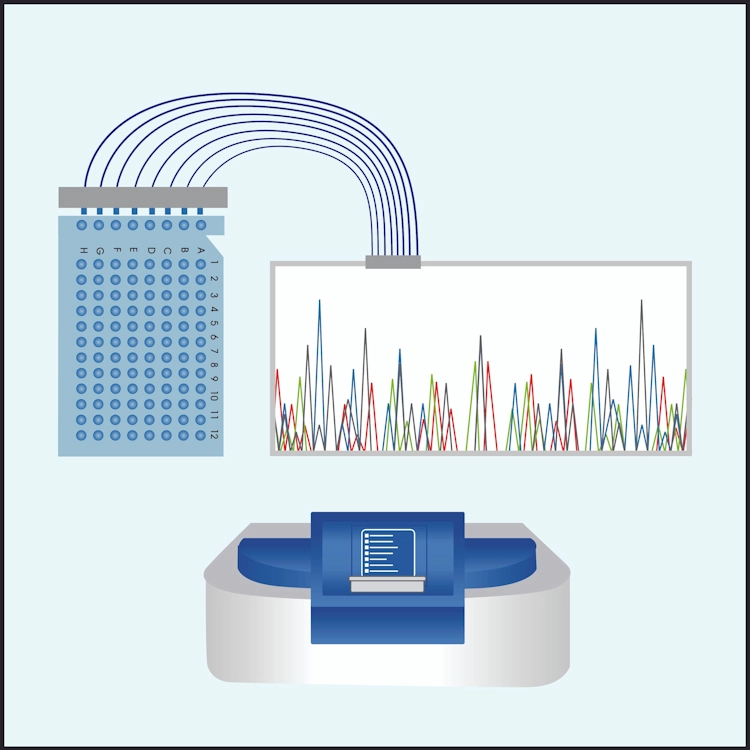
Capillary electrophoresis is a popular separation technique used in many applications. DNA sequencing, protein charge characterization, and peptide separations upstream of mass spectrometry are a few examples.
Prices of capillary electrophoresis systems vary according to the type, scale, and versatility required for a given application. The data analysis software, user interface, and other features have significant bearing on capillary electrophoresis system costs. Consumables and reagents are important considerations that must be factored into operational expenses as well.
What is electrophoresis?
Electrophoresis is a widely used technique in the lab that enables separations of biomolecules based on their charge and size. Electrophoretic separations take place in solution or in a gel-matrix under the influence of an electric field. Common electrophoresis types include polyacrylamide gel electrophoresis (PAGE) and agarose gel electrophoresis, which are used to separate proteins and nucleic acids, respectively.
What is capillary electrophoresis?
Capillary Electrophoresis (CE) separates molecules such as proteins and nucleic acids according to their charge or ionic mobility. CE follows many of the same physical principles as electrophoresis techniques such as PAGE. A major difference, however, is CE is performed using micrometer or nanometer diameter sized glass capillaries or channels.
Capillary electrophoresis versus gel electrophoresis
There are many advantages of using CE over traditional gel electrophoresis. These include:
- The submillimeter diameter capillary tubes or microfluidics channels dissipate heat better than traditional electrophoresis
- With improved heat dissipation, much higher voltages can be applied, thereby increasing the rate of separations
- CE gels can run faster with overall better resolution than conventional gels
- Sample can be detected directly within the capillary, as opposed to traditional gels which require handling and staining during detection
- Less sample volumes are typically required making the technique amenable to microfluidics
Capillary electrophoresis principle
CE encompasses a family of techniques all centered around the use of capillary-based separations. CE techniques include zone capillary electrophoresis, capillary gel electrophoresis (CGE), capillary isoelectric focusing (CIEF), capillary isotachophoresis, and micellar electrokinetic chromatography (MEKC).
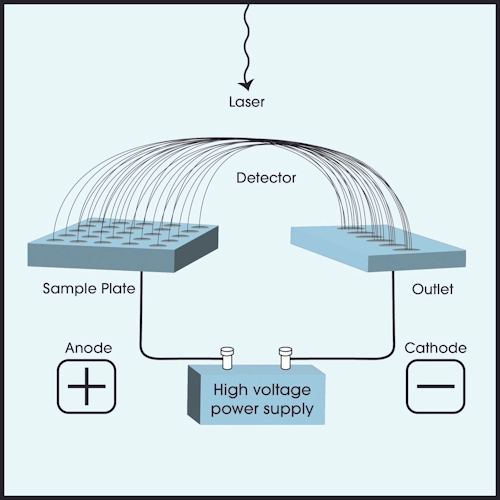
Capillary gel electrophoresis (CGE) is considered a discontinuous separations technique, where samples are separated using two distinct electrolyte vessels or zones connected via a capillary gel. CGE instrument setups consist of a high-power voltage supply, sample vessel(s), capillary tube(s), two separate electrodes, a detector, and a data output interface.
Zone capillary electrophoresis and isoelectric focusing (cIEF) are continuous separation techniques using solution-based electrolytes, rather than gel-based separations.
The figure shows a diagram of a typical capillary electrophoresis setup. An electric field is produced across anode and cathode electrodes driven by a high voltage power supply. Sample is introduced at the anode side and is separated according to ionic mobility within capillary tubes containing an electrolyte buffer solution or gel matrix, depending on the technique and application. An inline detector reads and directs results to data analysis software for interpretation.
Capillary electrophoresis instruments
The type of capillary separation technique depends on the analyte and the detection method. The most common instrument types include:
- CE Genetic Analyzer – Based on capillary gel electrophoresis (CGE) technology, these instruments are designed to integrate PCR-based DNA separations with fluorescence probe-based detection. Sophisticated data analysis software provides information on sequence identity as well quantitative determination according to system capabilities. Applications include high-throughput DNA sequencing for mutational analysis and genomics workflows. An example of a popular genetic analyzer platform is the ABI 3500 Series instruments from Thermo Fisher.
- CE Fragment Analyzer – These CGE instruments are designed for high-efficiency DNA or RNA separations and detection for quality control or purity analysis. Applications include QC for cell-free DNA isolation, NGS library preparation, RNA QC for RNA sequencing, and other methods. An example of a DNA/RNA fragment analyzer is the Promega Spectrum Compact instrument.
- CE protein analyzer – As an alternative to SDS-PAGE, these CGE instruments offer increased throughput and reproducibility and improved workflows with the ability to automate protein separations. Instruments may include IEF solutions-based separations modules for orthogonal analysis. Applications include characterization and charge variant analysis of proteins such as biotherapeutic antibodies. The Maurice from ProteinSimple is an example of an instrument that combines CE-SDS with cIEF analysis.
- CE-MS peptide chip analyzer – Based on zone capillary electrophoresis, these separation techniques leverage microfluidics to enable high-resolution separation of peptides in solution. Applications include upstream chip-based separations in tandem with mass spectrometry for proteomics workflows. An example of a system that combines micro fluidic chip CE with MS (CE-MS) is the Agilent 7100 CE system.
Capillary electrophoresis instrument cost
DNA sequencers can typically handle multiple 96-well plates with continuous operation. In addition to sample handling and fluidics, these systems may require the following data hardware and software components:
- A dedicated computer and monitor
- Data analysis software designed for high-throughput workflows
- RFID functionality for consumables tracking
- Dedicated space depending on unit dimensions
Enabling features such as the ability to interface with external components such as plate loading robots, reagent wash systems, and other devices, can add to the price of the system. Internal components including fluorescence lasers and CCD cameras for detection may require periodic service or replacement and should be factored into costs of operation.
DNA/RNA fragment analyzers can be aligned with smaller throughput operations. Price considerations of these systems may include:
- Touchscreen interface and built-in computer
- Software for sequence/fragment viewing
- Barcode reading functionality for sample tracking
- Benchtop size efficiency
Although often less sophisticated than high-throughput DNA sequencing systems, these instruments also use internal lasers and CCD cameras. All these features and considerations can impact price and costs of operation.
The latest instruments are capable of mid-throughput high-accuracy sequencing, fragment analysis, remote scheduling and monitoring, and other advanced capabilities.
Protein Analyzers using CE-SDS can support single sample or multiplexed protein analysis. Instruments that combine CE-SDS with capillary isoelectric focusing (cIEF) enable two-dimensional, orthogonal protein characterization of size and charge as well as isoelectric point determination, respectively. Key features of these systems may include:
- On-board sample handling and reagent mixing components
- Detectors for UV and/or fluorescence measurement
- Compatibility with pre-assembled separations cartridges to streamline efficiency and reproducibility
The dual functionality options, multiplexing capabilities, and other features impact system price.
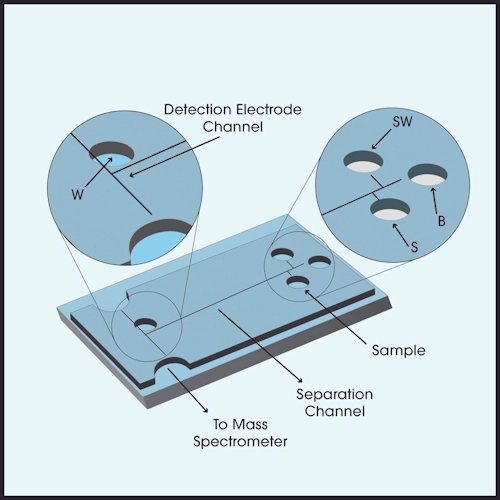 CE-MS techniques are based on capillary zone electrophoresis
incorporated in microfluidic devices and coupled with downstream mass spectrometers. The systems include a mountable unit that
affixes to the inlet of the mass spectrometer. Associated sample management and
separations components include:
CE-MS techniques are based on capillary zone electrophoresis
incorporated in microfluidic devices and coupled with downstream mass spectrometers. The systems include a mountable unit that
affixes to the inlet of the mass spectrometer. Associated sample management and
separations components include:- Microfluidic chips which are used and in certain cases reconstituted.
- Reagents and buffers typically included in each kit.
- Kits specific for each type of application, for instance metabolites or antibodies.
- Data analysis software.
The use of the various functionalized chips and associated buffers must be factored into the cost of operation.
The figure shows a diagram of a CE-MS microfluidic chip. Sample is introduced at a reservoir on the anode side of the chip. Sample waste (SW) and buffer (B) reservoirs serve to collect excess sample and allow rinse and wash of the microfluidic capillary channel. A detection electrode channel intersects with the separation channel where results are collected and directed for interpretation. The sample is then directed into the inlet of a mass spectrometer for analysis.
Consumables and reagents
Many DNA and protein CGE analysis systems are compatible capillary gels provided in either pre-cast batches or ready-to-use array cartridges.
- Buying precast capillary gels or gel cartridges in packs increases the reproducibility and convenience
- Costs related to the number of individual units per pack can impact the price - the larger the number in a pack, the lower the price per unit
- Precast units have a limited shelf life, so purchasing excess units may negatively impact costs if they cannot be used before the expiration date and must be discarded
Capillary electrophoresis consumables including buffers and reagents can often be purchased individually or in bundles. In addition, these consumables may be available as prefilled plug-and-play kits, which can offset operating needs and costs. Dedicated microplates, plate bases and retainers, septum mats, and other consumables must be factored into the costs of operation as well, depending on the instrument and application.
Capillary electrophoresis applications
CE instruments are used in a variety of applications where electrophoretic speed, accuracy, and precision are paramount. Forensic testing labs leverage the capabilities of capillary gel electrophoresis systems to perform DNA fingerprinting. Biopharma labs use capillary SDS gel electrophoresis and capillary isoelectric focusing techniques to assess size, charge, and charge variation of antibodies and quality control of biotherapeutics. Research labs incorporate microfluidics-chip based separations upstream of mass spectrometry for biomarker discovery and proteomics investigations among other applications.
Summary
There are important factors impacting cost considerations of capillary electrophoresis technologies. The type of separations analysis required will dictate aspects such as the throughput, sample handling, and consumables that are required. Buyers should be aware of the key on-board features, as well as components and consumables kits which can impact the upfront price and ongoing costs for these systems.
